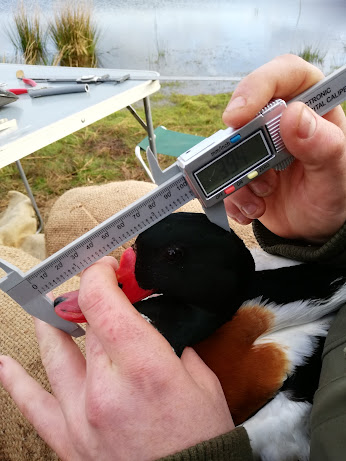Although there have been no advertised public ringing sessions at the Wetlands for a quite a while due to Covid, there have been a few interesting sessions.
Early last year the Abberton traps (wood & mesh cages used to trap ducks) were removed from the wetland in front of the Discovery Hut hide for renovation. They were replaced with much back-breaking effort on 9/12/21.
 |
| One of the two Abberton traps being assembled before being moved into place. |
For a few days before 14/12/21, the traps were baited with grain to encourage ducks into the trap. The roof & door were left open during this period to allow any ducks to escape, and then closed the day before the planned catch. Six members of the Group attended the session, which proved to be pretty quiet. We finished on 25 birds, not a lot for the length of nets used around the willows (which were disturbed by the volunteers clearing and burning), the brook, the feeders and the northern edge of the reeds. However, the Abberton traps were a success with ringing ticks for some members.  |
| Ringing areas in the vicinity of the Discovery Hut |
The new & re-trapped birds processed are shown below:
| Ringed | Re-trapped |
Blackbird | 3 | 2 |
Blue Tit |
| 2 |
Chiffchaff | 1 |
|
Dunnock | 2 | 1 |
Great Spotted Woodpecker | 1 |
|
Mallard | 3 | 1 |
Moorhen | 3 |
|
Robin | 3 | 2 |
Teal | 1 |
|
Totals | 17 | 8 |
 |
| The Teal was an adult female as indicated by the bold white edge on the tertial feather (arrowed) |
On 3/2/22 five members of the Group lugged the ringing kit to Colyford Common at the far north of the Wetlands, where a base was set up on the viewing platform.
The conditions for ringing were good, with none of the high winds forecast over the preceding few days. The early morning high tide made access to the two 18m nets in the reed bed a little tricky for a bit! Nets were put up in the reeds, the tram gate and the field gate. We put an L in the corner of the crop field, one further up in the bramble patch and another in the middle under the wires.
 |
| Ringing areas & net rides at Colyford Common |
33 birds were processed of 12 species as shown below:
| Ringed | Re-trapped |
Blue Tit | 6 | 2 |
Wren | 3 | 2 |
Greenfinch | 2 | 2 |
Blackbird | 1 | 2 |
Goldfinch | 3 |
|
Song Thrush | 1 | 1 |
Dunnock | 1 | 1 |
Long-tailed Tit | 1 |
|
Cetti’s Warbler | 1 |
|
Reed Bunting | 1 |
|
Chiffchaf | 2 |
|
Robin |
| 1 |
Totals | 22 | 11 |
One of the re-trapped Blue Tits was interesting, having been ringed on 17/7/17 as a juvenile at the feeders, and encountered again that September in the reed bed where it was caught this time. It had not been seen during the almost 4 1/2 year intervening period. The average age for a Blue Tit is about 3 years, so it's doing pretty well, although it has a way to go to beat the maximum recorded age of 10 years, 3 months and 10 days.
 |
| Greenfinch: Identified as a male by the amount of yellow spreading across the tail & primary flight feathers, and as an adult by the brightness of the yellow on the alula, the broad grey tips on the primary coverts, and the tail feathers which were black, round tipped & in good condition. |
And lastly, a session was held on 17/2/22. It was one of those days on the Axe. Quiet! The highlight from the nets by the feeders was a Great Spotted Woodpecker. A net was set over the brook for Kingfisher, which it delivered. Branches placed in the water in front of the net encourage them to fly into rather than under it.
The two Abberton traps in front of the Discovery Hut hide were set and having baited them in the days before, we expected the usual Mallard, Teal and Moorhen but the only bird seen inside, a Moorhen, found a way out. The Mallard seemed to prefer the pond in front of the Sand Martin wall where they are spoiled rotten by visitors to Seaton Wetlands.
A quiet session with only 11 birds, but an excellent opportunity for us to demonstrate bird ringing to a student who was with us for the morning. We were also joined briefly by an unusually confiding Water Rail.
The species ringed are shown below:
| Ringed | Re-trapped |
Blackbird | 2 |
|
Blue Tit | 2 | 1 |
Chaffinch | 1 |
|
Goldcrest | 1 |
|
Great Spotted Woodpecker | 1 |
|
Kingfisher |
| 1 |
Long-tailed Tit |
| 2 |
| 7 | 4 |
 |
| Kingfisher: A female, identified by the amount of red on the lower mandible. First ringed at the Wetlands on 27/08/2021 as juvenile. Photo by Peter Bennett. |
With the nets down, two of the Group were pleased to join another member who was enjoying a busier morning in a cover crop inland where the catch included ten Brambling
Peter Bennett















